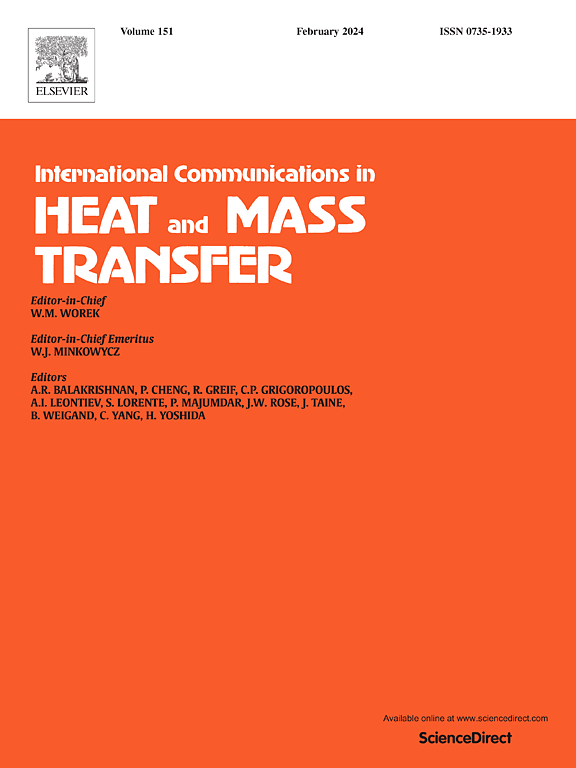Effect of liquid static pressure on critical heat flux characteristics in low-pressure pool boiling for dielectric fluid Novec 7100
IF 6.4
2区 工程技术
Q1 MECHANICS
International Communications in Heat and Mass Transfer
Pub Date : 2025-06-24
DOI:10.1016/j.icheatmasstransfer.2025.109243
引用次数: 0
Abstract
Two-phase direct immersion cooling with dielectric fluid offers excellent heat dissipation, as the demand for high-performance cooling increases due to the high performance and compactness of electronic devices. In this study, the effect of liquid static pressure on the heat transfer characteristics of pool boiling is investigated experimentally for the dielectric fluid Novec7100 under low-pressure conditions on a horizontal heating surface with liquid heights (H) ranging from 3 to 57 mm. The measurements reveal that the self-induced subcooled boiling effect on the critical heat flux (CHF) strongly depends on H and system saturation pressure. A unique subcooled boiling behavior, characterized by disappearing rising bubbles, is observed in the low-pressure range. The CHF initially decreases with lowering system pressure in lower pressure range. However, with further decreases in pressure, approaching liquid static pressure, CHF increase intensifies due to self-induced subcooled boiling, and the effect of H becomes more pronounced. In such low-pressure boiling, even if the overall system is near temperature equilibrium, it is necessary to consider the effect of subcooling near the heating surface. In correlations for saturated boiling, lower pressure results in greater discrepancies with measurements. However, the modified subcooled boiling correlation yields better qualitative and quantitative agreement.
液体静压对介质流体Novec 7100低压池沸腾临界热流密度特性的影响
由于电子设备的高性能和紧凑性,对高性能冷却的需求增加,电介质流体的两相直接浸没冷却提供了出色的散热。本文以介电流体Novec7100为实验对象,在液体高度(H)为3 ~ 57 mm的水平受热面上,研究了低压条件下液体静压对池沸换热特性的影响。测量结果表明,自致过冷沸腾对临界热流密度的影响很大程度上取决于H和系统饱和压力。在低压范围内观察到一种独特的过冷沸腾行为,其特征是上升气泡消失。在较低压力范围内,CHF首先随着系统压力的降低而降低。但随着压力进一步降低,接近液体静压时,CHF因自诱导过冷沸腾而增加,H的作用更加明显。在这种低压沸腾中,即使整个系统接近温度平衡,也需要考虑受热面附近过冷的影响。在饱和沸腾的相关性中,较低的压力导致与测量值的较大差异。然而,改进的过冷沸腾关系式在定性和定量上有更好的一致性。
本文章由计算机程序翻译,如有差异,请以英文原文为准。
求助全文
约1分钟内获得全文
求助全文
来源期刊
CiteScore
11.00
自引率
10.00%
发文量
648
审稿时长
32 days
期刊介绍:
International Communications in Heat and Mass Transfer serves as a world forum for the rapid dissemination of new ideas, new measurement techniques, preliminary findings of ongoing investigations, discussions, and criticisms in the field of heat and mass transfer. Two types of manuscript will be considered for publication: communications (short reports of new work or discussions of work which has already been published) and summaries (abstracts of reports, theses or manuscripts which are too long for publication in full). Together with its companion publication, International Journal of Heat and Mass Transfer, with which it shares the same Board of Editors, this journal is read by research workers and engineers throughout the world.

 求助内容:
求助内容: 应助结果提醒方式:
应助结果提醒方式:


